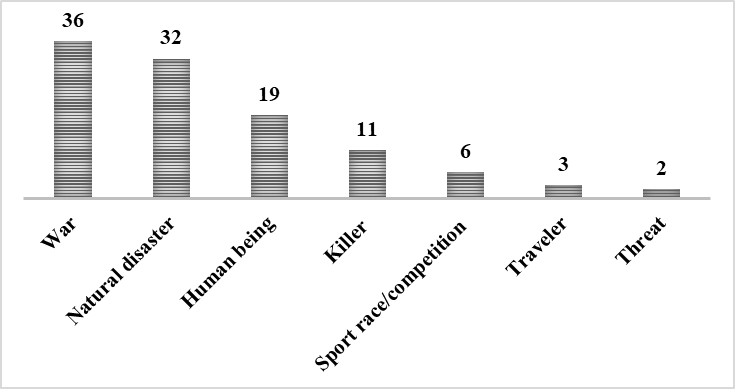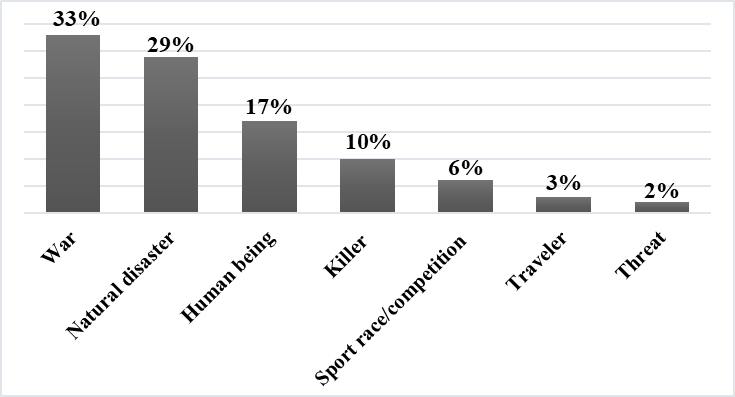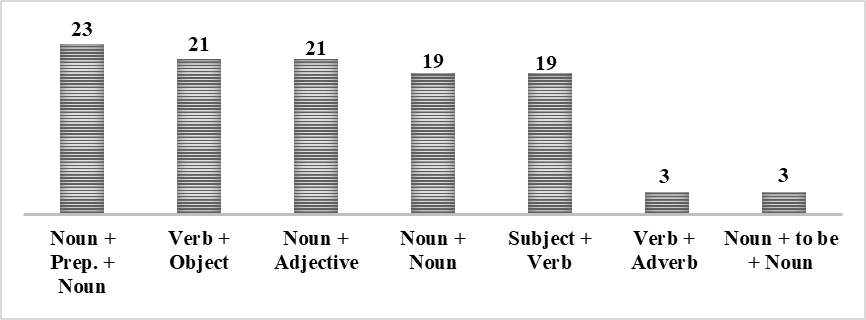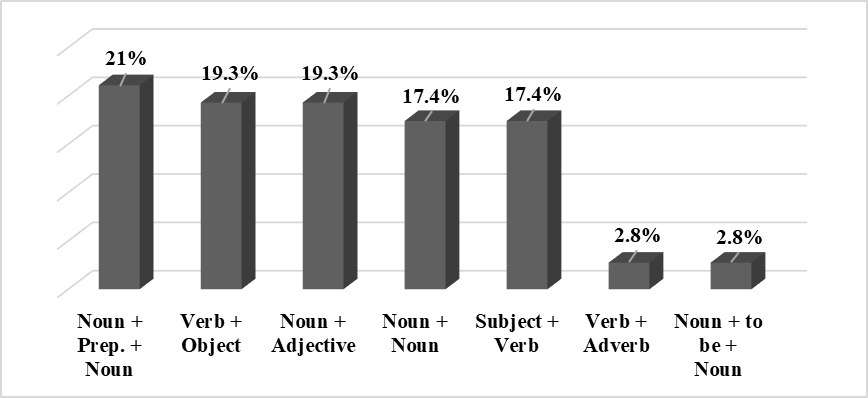Abstract
The article aims at analyzing types of metaphorical constructions used in the English economic discourse by applying a cognitive approach to the metaphor study. Based on the consideration of a cognitive approach to the study of metaphors and relevant research papers devoted to the topic, the most productive metaphorical models that characterize the period of the coronavirus pandemic and represent the concept of COVID-19 in modern English economic discourse have been elicited and analyzed with the help of structural-semantic, comparative and quantitative methods. The findings have allowed to assess the quantitative ratio and percentage ratio of the conceptual areas that served as source domains for the pandemic metaphorization. The analysis of substantive, verbal and adjectival metaphors and their components have been also carried out. 109 metaphors have been found. The most productive are the spheres of the source “WAR” and “NATURAL DISASTER”. Seven types of part-of-speech component constructions have been identified.
Keywords: COVID-19, conceptual metaphor, economic news, metaphorical constructions
Introduction
The last two years around the world have been marked with the pandemic of COVID-19. Each sphere of national and global economies has taken a severe toll which was reverberated in the social infrastructure: enterprises closed, educational institutions switched to distance learning, and restrictive measures were introduced to visit public places (Malyuga, 2016). These measures led to a fall in stocks, a decrease in the exchange rate, an increase in prices and interest rates on loans. The epidemiological situation resulted in a decrease in wages, a shortage of certain goods, a reduction in the number of jobs, an increase in the cost of goods and services, a ban on tourist trips, the cancellation of concerts, sporting events, etc. Such a development of the world has become an inevitable part of people’s daily lives and has been made record of in economic articles in newspapers, magazines or news sites. At the same time this large-scale phenomenon has found a linguistic reflection by the emergence of new lexical units (Kozlovskaya et al., 2020).
One of the most common linguistic means that most vividly and concisely describe various phenomena and events is a metaphor, the purpose of which is to draw the addressee’s attention to certain facts and conclusions, to manifest the author’s position and influence the addressee. Figurative expressions are widely-used tool of conveying meaning in business language, and business communicators tend to use metaphoric expressions both in written and spoken language forms. It is essential to use figurative language for keeping the audience interested. Metaphor adds colorings to the formal language of finance and economics.
Metaphor is defined as “an imaginative way of describing something by referring to something else which is the same in a particular way.” (Collins Dictionary, n.d.). One of the most discussed and applied notions in modern linguistic research is that of conceptual metaphor (Kövecses, 2020; Lakoff, 1993; van Dijk, 2008). The conceptual metaphor theory was first introduced by American linguists George Lakoff and Mark Johnson (1980). Lakoff and Johnson published their famous monograph “Metaphors we live by” which is one of the most significant works within cognitive linguistics.
Problem Statement
As it is known, in classical view a metaphor study is seen as the finding of the similarity or analogy between the metaphorical language and its literal equivalent. Researchers supporting this idea of analogy and similarity, for example, include Mooij and Fogelin. They argued that “metaphors are the comparison of some pre-existing similarities between two real objects without the word “like” being stated in the sentence” (Leezenberg, 2003, p. 704). In this regard, metaphorical expressions can always be substituted by other literal word colocations without losing their meaning.
Also, a metaphor should be understood as a word that has become a component of a metaphorical phrase and, as a result, has received a metaphorical meaning that performs the function of a figurative characteristic of another component, expressing with the latter a figurative representation or a figurative judgment.
However, as noted above, many linguists have emphasized the cognitive value of metaphor. That is, metaphor is part of the thought process. I. A. Richards opposed the classical point of view, following from which, the metaphor is based on the resemblance of two dissimilar notions. Instead, he argued that the interpretation of metaphors motivates and creates similarities.
Black’s interaction theory, based and further developed on the basis of Richards’ theory of metaphor, renames Richards’ terms “tenor” and “vehicle” into “frame” and “focus”. In addition, Black, following Richards’ ideas, also tried to interpret metaphors at a cognitive-conceptual level, a level different from treating metaphors as mere language (Black, 2012).
He wrote that metaphor is the interaction of implications systems of the two domains, an idea similar to Richards’ notion of “interaction between two thoughts” (Black, 2012). Moreover, in the process of interpreting the metaphor, new meanings of the two domains are created and it cannot be reduced to a literal meaning (Murashova, 2021).
Lakoff and Johnson (1980) changed the classical view and developed a new theory that has been known as the cognitive view of metaphor. Based on the central idea that language reveals thoughts, Lakoff and Johnson proposed the Conceptual Metaphor Theory. Deignan summarizes the provisions of Conceptual Metaphor Theory into five main statements:
- “Metaphor structures thinking;
- Metaphor structures knowledge;
- Metaphor is central to abstract language;
- Metaphor is grounded in physical;
- Metaphor is ideological” (Deignan, 2008).
Metaphors in English economic texts can reflect the characteristics, values, beliefs and judgments that prevail in the language of business communication in English-speaking countries and in many international companies.
Figurative language has always been used in business communication with metaphoric expressions being the most frequently used elements. Even during a skimming of terminological dictionaries, we see the presence of metaphorical terminology that is well-established in the lexicon and is oftеn not perceived by people as metaphors (price war, weak currency, freezing prices, shadow economy, etc.).
Thus, many economists and linguists, such as Teun van Dijk, Henderson, McCloskey, Boers, and Charteris-Black have made research on metaphor in economic discourse in the past decade. In the studies, they agree that “metaphors in economic contexts play a significant role in comprehending abstract economic theories and complex economic phenomena” (Boers & Demecheleer, 1997). Metaphors in economic discourse can also be “firmly established in people’s mind and form a constitutive part of people’s conceptual framework” (Duddley-Evans & Henderson, 1990, p. 5). Such economic metaphorical collocations as employees are human capital, equity indexes fall, the inflows of foreign capital, the rebound in stocks were gradually got absorbed into people’s way of thinking and formed a constitutive part of people’s conceptual system (Charteris-Black, 2004).
The classification of metaphors, as well as other means of the language, including figurative and expressive, is carried out on different grounds. Therefore, most of the metaphor classification parameters can be reduced to two large groups: semantic and structural (Trofimova, 2013).
Scholars have suggested numerous classifications of metaphors (Malyuga & Madinyan, 2021), which fall into:
- Semantic (focused on the nature of semantic relationship between source and target domains: structural, orientational, ontological);
- Structural – this includes part-of-speech classification (substantive, verbal, adjectival, adverbial metaphors) and part-of-sentence classification (substantive, predicative, attributive, adverbial metaphors);
- Functional (according to an identifying (classifying) or predicating (characterizing) function of a metaphor).
The most consistent, complete and significant for our work is the part-of-speech classification of C. Brooke-Rose’s, which is based on the part of speech and the pattern of a metaphor. The classification distinguishes five types of metaphor: substantive (expressed by nouns and noun phrases), verbal (represented by verbs and verbal forms), adjectival (revealed in adjectival modifiers) and adverbial (expressed by adverbial modifiers) metaphors with their subdivisions (Brooke-Rose, 1958).
Beside all mentioned, an integral feature of modern linguistics is the study of language in its various aspects and manifestations, namely in cultural, political, social, economic. One of the main areas of current research is the study of discourse (Karasik, 2004). “Economic discourse is a type of discourse, during the deployment of which the process of speech production is carried out on the basis of analysis or rethinking of certain economic realities” (Arutyunova, 1990, p. 7). At the same time, economic discourse can be attributed to varieties of institutional discourse, since economics is an integral part of people's daily lives.
Therefore, much research in various field was made based on the conceptual metaphor theory. However, there is a certain lack of studies devoted to the use of metaphorical constructions in economic discourse especially during the spread of the COVID-19 pandemic. It is necessary to analyze metaphor usage in nonliterary texts with reference to economics, especially media economic texts where metaphors are often overlooked
Research Questions
The research is intended to give answers to the following questions:
What are the key structural patterns of metaphorical constructions in the English economic discourse?
What are the most commonly used metaphorical constructions in economic discourse based on structural (part-of-speech) classification?
Purpose of the Study
The objective of this research is to elicit types of metaphorical constructions and study their usage in economic discourse by applying cognitive approach to metaphor study.
Research Methods
Research methods are selected based on the definition of the objective, tasks and object of the study:
1) structural-semantic method – to analyze of the process of forming metaphors as linguistic signs and ways of replacing the economic realities with metaphors;
2) the comparative method – to make a comparative analysis between different types of metaphoric frames;
3) quantitative method – to define most frequently used types of metaphorical construction in economic discourse.
Findings
Conceptual metaphors of COVID-19 pandemic
The study of conceptual metaphors of the COVID-19 pandemic in BBC News, The Times and Financial Times provided evidence to the fact that the target meaning of metaphors is actual for the coverage of various topics, directly or indirectly related to the spheres of economic and business. This can be explained by the sudden, global and prolonged impact of the pandemic on the economies of countries.
For the study, we have selected 40 articles from the newspapers BBC News, The Times, The Sunday Times, Financial Times for further analysis of conceptual metaphors. We have found 109 metaphorical constructions and divided them into 7 conceptual groups (metaphors) depending on their definition and semantic meaning. As a result, the sources of the analyzed metaphorical models are knowledge from a variety of conceptual areas, among which are the spheres WAR, NATURAL DISASTER, HUMAN BEING, KILLER, SPORT RACE/COMPETITION, TRAVEL, THREAT which once again emphasizes the anthropocentric nature of the metaphorization process and reflects a negative assessment of ongoing events (see Table 1).
The prevalence of war metaphor can be explained by the universal essence of the concept COVID-19 PANDEMIC – WAR and COVID-19 PANDEMIC – NATURAL DISASTER. As the results in the table show, the number of metaphors related to the conceptual areas of WAR and NATURAL DISASTER is almost the same. This is due to the destructive power of the above-mentioned phenomena. In both cases, the coronavirus is a severe disease that suddenly appeared and spread around the world. It “attacks”, “hits”, “destroys” and leaves terrible consequences for the economic and health spheres of society. We propose to consider the most frequently used conceptual metaphors in the following examples:
- Hong Kong has imposed stringent measures to tackle the pandemic, such as a ban on passenger flights from eight nations including the UK and the closure of bars, cinemas and gyms (Hong Kong officials consider Beijing’s help to contain Covid 25.01.21) (Financial Times, 2021).
- “A looming wave of the Omicron variant threatens to weigh on consumer spending, particularly on face-to-face services,” Alex Holmes, an economist at Capital Economics, said (South Korean economy grew at fastest pace in 11 years in 2021 25.01.21) (Financial Times, 2021).
If in the case of the conceptual metaphor of WAR, the coronavirus acts as an attacking enemy against which humanity is fighting, then in the case of a NATURAL DISASTER, a pandemic is more comparable to such disasters as a storm, hurricane, flood, etc. which imply a destructive force.
The results of the quantitative (see Figure 1) and percentage ratio (see Figure 2) are also presented on the figures.


It is worth to mention the smallest group of conceptual metaphors, Covid-19 pandemic - threat. As seen in Figure 1 and Figure 2, we decided to single out these metaphors separately in terms of their semantic and contextual meaning and separate them from the conceptual metaphor of war. As shown in the examples below, the name of the coronavirus is omitted by the author and replaced by the metaphorical phrase “shared threat” and the noun “risk”. These metaphors are separated from the conceptual sphere of war, since here the author describes possible, but not yet occurred, consequences for the economy that could appear after the spread of the pandemic.
- Widening disparities within and between countries will not only make it more difficult to control Covid-19 and its variants, but will also risk stalling, joint action against shared threats that the world cannot afford to overlook (World Bank warns global economy faces grim outlook 11.01.21 (Sherman, 2021).
- The agency also mentions the possibility of new virus variants as a risk to economic prospects (OECD: Prospects brighter for global economy 9 March 2021) (Walker, 2021).
Metaphorical constructions of COVID-19 pandemic
We also devoted our research to the identification of structural, namely part-of-speech types of metaphors according to C. Brooke-Rose’s classification which distinguishes four types of metaphors: substantive, verbal, adjectival and adverbial metaphors The analysis was carried out on the same 40 articles as the analysis of conceptual COVID-19 metaphors. We have considered 109 metaphors; it should be noted that we have not found adverbial ones among them (see Table 2). Substantive and verbal metaphors are the most numerous types.
The results presented in the table demonstrate substantive and verbal metaphors are the biggest groups by the number of metaphorical constructions. However, most metaphors in economic articles are belong to the substantive type, where a noun is the main component that contains a metaphorical meaning. This is the most used part of speech for metaphor formation, since it can create word-combinations both with other parts of speech and with the noun itself.
We have classified each type of substantive, verbal and adjectival metaphors according to the part-of-speech components and identified seven types of constructions (see Table 3).
The results of the quantitative (see Figure 3) and percentage (see Figure 4) analysis are presented on the figures.


Let us consider several examples. The metaphorical meaning of the constructions is represented by the part of speech that is in bold type.
As seen in Figure 3 and in Figure 4 the biggest substantive metaphorical subgroup is presented by Noun + Prep. + Noun constructions:
One of the biggest subcategories among verbal metaphors is Subject + Verb constructions: virus is, Omicron, Omicron, pandemic was, Covid, coronaviruses, variants, pandemic.
Adjectival metaphors (8) are presented only by Adjective + Noun constructions:variants Covid-19 has been pandemicDeltavariants.
Conclusion
The study showed that the metaphorization of modern economic media discourse is becoming universal, there is a convergence of metaphorical pictures of the world of different cultures, which is associated with the current processes of globalization that blur national and cultural boundaries. The use of metaphors to represent the notion of “coronavirus” is aimed at shaping public consciousness and a linguistic picture of the world. However, the very concept of “coronavirus” can serve as a source of metaphor.
The analysis of the material made it possible to assess the quantitative and percentage ratio of the conceptual areas that served as sources for COVID-19 pandemic metaphorization.
The research was also devoted to the study of the structural (part-of-speech) components of metaphors. We have demonstrated the analysis of substantive, verbal and adjectival metaphors and identified seven types of constructions.
The research prospects include: further development of the conceptual metaphor theory, a study of vocabulary reflecting the coronavirus reality, further examination of conceptual metaphors that could serve as source domains for the COVID-19 metaphorization.
Acknowledgments
This paper has been supported by the RUDN University Strategic Academic Leadership Program.
References
Arutyunova, N. D. (1990). Metafora i diskurs [Metaphor and Discourse]. Progress.
Black, M. (2012). Metaphor and thought. Cambridge University Press.
Boers, F., & Demecheleer, M. (1997). A few metaphorical models in (western) economic discourse. In W-A. Liebert, G. Redeker & L. Waugh (Eds.), Discourse and Perspective in Cognitive Linguistics, (pp. 115-129). John Benjamins. https://doi.org/10.1075/cilt.151.10boe
Brooke-Rose, C. (1958). Grammar of Metaphor. Seeker & Warburg.
Charteris-Black, J. (2004). Corpus Approaches to Critical Metaphor Analysis. Palgrave MacMillan.
Collins Dictionary. (n.d.). Metaphor. In collinsdictionary.com dictionary. Retrieved on March 3, 2022, from https://www.collinsdictionary.com/search/?dictCode=english&q=metaphor
Deignan, A. (2008). Corpus linguistic data and conceptual metaphor theory. John Benjamins.
Duddley-Evans, E., & W. Henderson. (1990). The Language of Economics: The Analysis of Economics Discourse. Macmillan.
Hong Kong officials consider Beijing’s help to contain Covid (2021, January 25). Financial Times. https://www.ft.com/content/6bbcbe98-55e8-46e4-9b0b-6768fe53b37e
Karasik, V. I. (2004). Iazykovoi krug: lichnost', kontsepty, diskurs [Language Circle: Person, Concepts, Discourse]. Gnozis.
Kövecses, Z. (2020). Extended Conceptual Metaphor Theory. Cambridge University Press. https://doi.org/10.1017/9781108859127
Kozlovskaya, N. V., Rastyagaev, A. V., & Slozhenikina, J. V. (2020). The creative potential of contemporary Russian political discourse: From new words to new paradigms. Training, Language and Culture, 4(4), 78-90.
Lakoff, G. (1993). The contemporary Theory of Metaphor. To Appear in Ortony, Andrew (ed.) Metaphor and Thought (2nd ed., pp. 202-251). Cambridge University Press.
Lakoff, G., & Johnson, M. (1980). Metaphors We Live By. The University of Chicago Press.
Leezenberg, M. (2003). Contexts of Metaphor. Cambridge University Press.
Malyuga, E. (2016). Exploiting the potential of ICT: assessment of students' knowledge. In 3rd International Multidisciplinary Scientific Conference on Social Sciences and Arts, SGEM 2016. AUG 24-30, 2016. Book 1: Psychology and Psychiatry, Sociology And Healthcare, Education Conference Proceedings, (Vol. III., pp. 319-325).
Malyuga, E. N., & Madinyan, E. I. (2021). Metaphorical representation of events in American news mediadiscourse. Scientific journal Modern linguistic and methodical and didactic research, 2(50), 17-28.
Murashova, E. P. (2021). The role of the cognitive metaphor in the hybridisation of marketing and political discourses: An analysis of English-language political advertising. Training, Language and Culture, 5(2), 22-36.
Sherman, N. (2021, January 11). World Bank warns global economy faces grim outlook. BBC News. https://www.bbc.co.uk/news/business-59946302
South Korean economy grew at fastest pace in 11 years in 2021 (2021, January 25). Financial Times. https://www.ft.com/content/8d25dd33-4b84-4580-bc71-9357b5e16a56
Teun A. van Dijk, (2008). Discourse and Context: A Sociocognitive Approach. Cambridge University Press.
Trofimova, Iu. M. (2013). Lingvistika poeticheskogo teksta: iazykovaia praktika kak «sklad rechei» i poeticheskoe tekstopostroenie [Poetical Textlinguistics: Speech Practice and Poetical Text Formation]. In Teoreticheskie i prikladnye aspekty izucheniia rechevoi deiatel'nosti (pp. 290-299).
Walker, A. (2021, 9 March). OECD: Prospects brighter for global economy. BBC News. https://www.bbc.co.uk/news/business-56335916
Copyright information

This work is licensed under a Creative Commons Attribution-NonCommercial-NoDerivatives 4.0 International License.
About this article
Publication Date
12 October 2022
Article Doi
eBook ISBN
978-1-80296-957-3
Publisher
European Publisher
Volume
4
Print ISBN (optional)
-
Edition Number
1st Edition
Pages
1-399
Subjects
Teaching methods, language for specific purposes, business English, translation studies, applied linguistics, intercultural business communication
Cite this article as:
Repetskaia, E. R., & Ivanova, A. G. (2022). Metaphorical Constructions in the Age of COVID-19 Pandemic. In V. I. Karasik, & E. V. Ponomarenko (Eds.), Topical Issues of Linguistics and Teaching Methods in Business and Professional Communication - TILTM 2022, vol 4. European Proceedings of Educational Sciences (pp. 281-290). European Publisher. https://doi.org/10.15405/epes.22104.32

